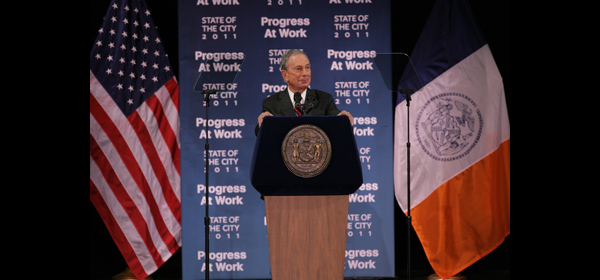
Photo by: City Hall
Mayor Bloomberg delivers his State of the City address.
Mayor Bloomberg’s state of the city speech on Wednesday offered inspiring words about guns and immigrants and a raft of new policy ideas. But as might be expected in a mayor’s 10th such address, much of the talk was about what has been accomplished so far. Here are some details on the mayor’s talking points:
Between November 2009 and November 2010 (the latest month for which detailed statistics are available), the city’s unemployment rate dipped from 10.5 to 9.1 percent and the labor force remained roughly constant, meaning the decrease in the unemployment rate can be attributed to people getting jobs, not giving up looking for them. The city is still down about 100,000 jobs from the local labor market peak of March 2008, when unemployment was at 4.6 percent. While enjoying a lower rate than the national economy, the city still has the highest unemployment of any metro area in the state.
About 350,000 people are on welfare in the city today–far lower than the million-plus that received cash assistance in 1995–and the city’s Human Resources Administration points with pride to the fact that the rolls have kept dropping or stayed low even as local unemployment soared. HRA did place tens of thousands of welfare applicants in jobs last year. But the agency also increasingly turned welfare applicants down.
The mayor did not mention the word “poverty” in his speech. Four years earlier, in his 2006 State of the City address, the mayor said he was “committing to a major reduction in the number of children, women and men who live in poverty in this City over the next four years.” The poverty rate dropped from 19 percent in 2005 to 17.6 percent in 2008, but in 2009 crept back up to 19 percent.
The decline in fire deaths, which tracks a national trend, is pretty impressive. Just since 1993, the number of civilian fire fatalities in the five boroughs slid from 161 to around 60 last year.
Over the mayor’s entire tenure, the increase is even higher, with the graduation rate leaping 33 percent since 2001. And more students are earning Regents diplomas–a good thing, too, since the local diplomas that about 15 percent of students earn will be phased out soon. Graduation rates have increased among all demographic groups, but substantial achievement gaps remain. Whites and Asians in the class of 2005 graduated at rates of 74 and 77 percent, respectively. Blacks and Hispanics graduated at rates of 52 and 54 percent.
Sixty percent of the 5,000 apartments at Hunter’s Point South are supposed to be affordable; the rest are market rate. Two-thirds of the affordable housing being constructed there will be reserved for people making between 81 percent and 165 percent of the area median income, or AMI. For a family of four that income range translates to $63,000 to $130,000. One-third of the affordable housing will be available to families making less than 80 percent of the AMI, or $63,000.
Willets Point isn’t an ash pile these days–it’s a bustling, if ugly and polluted, working neighborhood with 1,700 blue-collar jobs. The city says its plan for a hotel, convention center and mixed-income housing will create 5,300 permanent jobs.
Chung-Wha Hong, the executive director of the New York Immigration Coalition, in a statement praised the mayor for once again articulating his support for immigrants. But she added: “At the same time that we are buoyed by his comments on immigration reform, we are also concerned that immigrant students still learning English have been left out of the graduation-rate gains he cited in his speech. Students still learning English have significantly lower graduation rates, and we need to see the Mayor make a real commitment to improving outcomes for these students, who otherwise represent an enormous loss of economic potential that our city cannot afford.”
City Comptroller John Liu says this claim about the increase of MWBE contracting “cannot be substantiated.”Liu’s office has recently reported on several city agencies that did not comply with MWBE contracting rules.
There’s no question that pension costs are swallowing an increasing share of the city’s budget, and this is only partly due to investment losses in the pension funds’ stock portfolio. But there is wide variation in how generous city pensions are. According to the Citizens Budget Commission, Fire Department employees who retired in 2006 earned an average pension of $73,000. Cops’ average pension was $57,000. For teachers, it was $55,000. For other municipal workers the average was $30,098. For all retirees, the averages were lower. The city’s largest municipal union, District Council 37, says its retirees earn an average of $17,000.
And while it’s true that most employers have moved away from defined benefit pensions to the 401(k) model, it’s an open question whether that has been good for workers.
In his speech, the mayor made two references to falling crime rates. He did not mention that the number of murders in New York rose 15 percent last year. The 2009 murder count was a record low, however, and a reflection of the city’s success in defying the conventional wisdom that a lousy economy would mean sharply higher crime.
But there are doubts about the veracity of some crime statistics–so much so that NYPD commissioner Ray Kelly recently appointed a three-person panel to investigate the stats. While the NYPD has employed some “innovative new law enforcement strategies,” it also stopped and questioned or frisked New Yorkers more than 1.5 million times from 2007 through 2009.
This is a reference to the Summer Youth Employment Program, a resource so popular that in 2009, the city received 140,000 applications for 52,000 slots. Last year federal funding shrank and state support dried up; Bloomberg also threatened to cut tcity funding during the annual budget dance, but ended up inserting more money to offset some of the state’s retrenchment.








